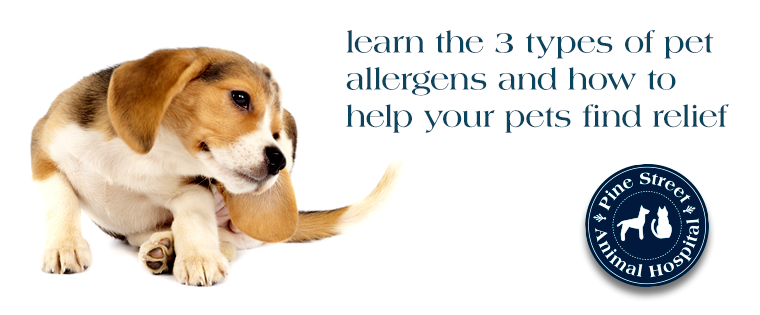Of all the conditions we see, allergic skin disease (ASD) has to rank near the top as the most frustrating for everyone involved. To help limit and alleviate some of that frustration, let me start by telling you the ending of the story first. There is NO cure for skin allergies, only control. If your dogs or cats are allergic, then they will ALWAYS be allergic. I wish it weren’t so, but there it is.
Now, just because there’s no cure doesn’t mean there isn’t hope. But hope starts with understanding how allergic skin disease works. You see, it isn’t the allergen that is the problem; it is how the body’s immune system reacts that causes all the trouble. So when we treat ASD we are really battling the immune system, and that can be tough.
Allergies can be broken into three categories: environmental, food and insect. Environmental is the toughest to control because these allergens are everywhere and can even be airborne. Examples of environmental allergies include pollens, molds, mold spores, house dust, and grasses. In the case of environmental allergens, avoidance is the hardest method of treatment and least effective. In order to find the specific allergens, pets have to undergo intradermal allergy testing by a dermatologist.
Foods are the next on the list and also hard to control. On the surface it seems simple: find out which food is the trigger and avoid it. Trigger foods can be protein based or carb based, so it isn’t always the meat source as many believe. Food trials are the only way to go here. In order for a food trial to be successful, there can be NO OTHER foods ingested but the trial food for up to 3-4 months before you can say for sure if the food is working or not. If it doesn’t work, you scratch that food and move on to the next. Start the process over and repeat until you see positive results. And if the pet ingests one thing other than that food during the trial, the clock gets reset back to zero and you have to start all over. The cheapest and easiest place to start is eliminating gluten and grains from the diet and then work on different protein sources from there.
The last allergen to consider is insect allergies. The most common is fleas, but pets can also be allergic to house dust mites. Of all the allergens, fleas are the easiest and least expensive to control. Simply put your pet on a good flea control product, use it correctly, and use it regularly year round, and you have eliminated one-third of the allergic triad. It’s that easy. In heavy flea populations, it may be necessary to treat not only the pet but also the premises. Wherever your pets are, so are the fleas.
As frustrating as ASD can be, there is hope. We have access to a wonderful veterinary dermatologist who specializes in helping these animals. From our side of things, there have been some amazing advancements in medications that are working very well (see some examples of allergy relief medications here, but always talk to your vet first). These medications can be costly but provide much-needed relief for chronic allergy pets. If you have an allergic pet, you understand how heartbreaking and frustrating it can be to watch them itch, get better with meds, then start all over again once the medications are finished. Contact us and set up a time to discuss a specific plan for the best long-term approach.



